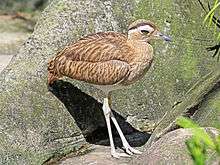Peruvian thick-knee
| Peruvian thick-knee | |
|---|---|
 | |
| In Jacksonville Zoo | |
| Scientific classification | |
| Kingdom: | Animalia |
| Phylum: | Chordata |
| Class: | Aves |
| Order: | Charadriiformes |
| Family: | Burhinidae |
| Genus: | Burhinus |
| Species: | B. superciliaris |
| Binomial name | |
| Burhinus superciliaris (Tschudi, 1843) | |
The Peruvian thick-knee (Burhinus superciliaris) is a species of bird in the family Burhinidae. It is found in Chile, Ecuador, and Peru. Its natural habitats are subtropical or tropical dry shrubland, subtropical or tropical seasonally wet or flooded lowland grassland, and pastureland. It is a ground-dwelling bird and feeds on insects and small animals.
Description
This medium-sized bird has brownish-grey plumage with brown streaks and spots. The underparts are white and the legs are yellow and long. There is a white streak through the eye with a black upper border. The short beak has a black tip. The length is about 40 cm (16 in).[2]
Distribution and habitat
The Peruvian thick-knee is found in South America in the coastal strip between the Pacific Ocean and the Andes. Its range extends from northern Chile, through Peru to southern Ecuador. Its typical habitat is semi-desert areas, agricultural land, dry pasture or well-vegetated river valleys. It particularly favours open crops such as alfalfa or corn.[2][3]
Biology
The Peruvian thick-knee is most active at night. The diet is not known but the bird moves about on the ground foraging, probably feeding on insects, small lizards and other small animals.[4] It runs across the ground in a manner similar to an ostrich.[2] It roosts in the open during the day, remaining motionless and difficult to spot as it is well-camouflaged by its brownish plumage. Its presence in an area may be most easily detected by its distinctive three-toed footprints in soft sand, and at night by its calls which are somewhat reminiscent of a lapwing (Vanellus sp.).[3]
Little is known of the reproduction of this species[4] but a nest containing two eggs has been observed in June on the Cerros de Naupe, a range of low mountains in Peru. The nesting site was on a dry, sparsely-vegetated slope with clumps of shrubs and cacti. The nest was a scrape in the ground with the area around it cleared of debris. The eggs were cream-coloured with blotches of tan and darker brown and measured approximately 53 by 39 millimetres (2.1 in × 1.5 in). One parent was incubating the eggs while the other stood in the shade a few metres away.[5]
Status
The IUCN has listed the Peruvian thick-knee as being of "least concern". This is because, although it is confined to a somewhat restricted range the bird is quite common, especially in the northern part of that range, and although the population trend is unknown, the bird does not appear to qualify for a more threatened category.[1][4]
References
- 1 2 BirdLife International (2012). "Burhinus superciliaris". IUCN Red List of Threatened Species. Version 2013.2. International Union for Conservation of Nature. Retrieved 26 November 2013.
- 1 2 3 "Huerequeque (Burhinus superciliaris)". Aves del Peru (in Spanish). Peru Ecologico. Retrieved 2014-08-07.
- 1 2 "Burhinus superciliaris". Neotropical Birds. Cornell Lab of Ornithology. 2010. Retrieved 23 August 2014.
- 1 2 3 Hume, R. (1996). del Hoyo, J.; Elliott, A.; Sargatal, J.; Christie, D.A.; de Juana, E. (2013). Handbook of the Birds of the World Alive, eds. "Peruvian Thick-knee (Burhinus superciliaris)". Lynx Edicions. Retrieved 24 August 2014.
- ↑ Williams, Morris D. (1981). "Description of the Nest and Eggs of the Peruvian Thick-Knee (Burhinus superciliaris)". The Condor. 83 (2): 183–184. JSTOR 1367428. doi:10.2307/1367428.
